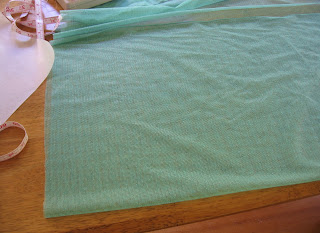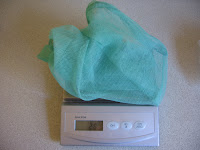Many of us are trying our best to eradicate excess packaging and plastic bags from our lives and although in Australia we are doing better with plastic shopping bags, at the supermarket we still put our fruit and vegetables into smaller plastic bags. Some shoppers don't use them for things like a bunch of bananas or a rock melon, but it's a bit hard when you are buying beans of snow peas, you need something to put them in.
Inspiration for making my own reusable bags for fruit and veges came after seeing a fellow painter at art class with a small lightweight reusable bag made of some type of nylon material which was see through. The bag was obviously manufactured by one of the companies producing "green" products and although I didn't ask how much they cost, I imagine it was a rather expensive as any "green" purchase seems to have a high price tag attached.
The material the manufactured bag is made from isn't available at the fabric shop, so instead I chose a nylon curtain fabric. It's cheap and fairly lightweight, so won't add too much extra weight to my produce at the register. It's almost mesh like so the person at the register can see what product is in the bag and it's also relatively strong. It's going to be much stronger than a plastic bag that's for sure. The materials I'm using can be easily washed and dried if necessary.
So here are some photos I took while making the bags. I've made two, more will be in production tonight.
I found it very hard to keep the material on the table as it kept slipping.
I cut out a paper pattern the size I wanted my bag allowing an extra couple centimetres for a seam allowance. One edge of the pattern was placed on the fold and off I went cutting.
Only very basic sewing skills are needed to sew these bags and here I am hemming the bottom and side edges in straight stitch. I didn't use pins, yes I'm slack, but I'm wasn't making a dress so it didn't matter.
I double stitched the bottom and side seam for extra strength.
I'm starting make the casing for the drawstring part of the bag. The top edge of the material is folded once and straight stitch hemmed right around. The bag is inside out as you sew this hem.
To complete the casing, fold the hem under leaving a couple of centimeters to allow the cord or string to be fed through. Hem right around on the lower edged remembering to leave a space to feed cord through.
Measure enough cord to go through the casing with extra to tie a knot at the end.
I've used a synthetic cord which is likely to fray. I've melted the ends to stop this happening, however if you don't like the sound of that, you could use a product like Stopfray.
I've attached the cord to a large safety pin to thread the cord through the casing.
When you have threaded the cord all the way through the casing, tie a knot to prevent the ends of the cord slipping back into the casing. Turn your bag inside out and you have a wonderful environmentally friendly fruit and vege produce bag.

Out of interest, I weighed both a supermarket plastic produce bag and my homemade produce bag.

The plastic bag weighed in at 1 gram and my bag at 26 grams. The extra weight of 25 grams at the register is a small price to pay for helping the environment.
I realise this post might be rehashing what someone else has done on another blog I'm unaware of. If that's the case, my apologies. I'm not too good at explaining things so I won't call this a tutorial. I'm sure it's way to simplistic for advanced sewers and confusing for beginners. If anyone has any questions, please email me.
Have a great day everyone and thank you for being patient with this rather long post.
Anne
Only very basic sewing skills are needed to sew these bags and here I am hemming the bottom and side edges in straight stitch. I didn't use pins, yes I'm slack, but I'm wasn't making a dress so it didn't matter.
I double stitched the bottom and side seam for extra strength.
I'm starting make the casing for the drawstring part of the bag. The top edge of the material is folded once and straight stitch hemmed right around. The bag is inside out as you sew this hem.
To complete the casing, fold the hem under leaving a couple of centimeters to allow the cord or string to be fed through. Hem right around on the lower edged remembering to leave a space to feed cord through.
Measure enough cord to go through the casing with extra to tie a knot at the end.
I've used a synthetic cord which is likely to fray. I've melted the ends to stop this happening, however if you don't like the sound of that, you could use a product like Stopfray.
I've attached the cord to a large safety pin to thread the cord through the casing.
When you have threaded the cord all the way through the casing, tie a knot to prevent the ends of the cord slipping back into the casing. Turn your bag inside out and you have a wonderful environmentally friendly fruit and vege produce bag.

Out of interest, I weighed both a supermarket plastic produce bag and my homemade produce bag.

The plastic bag weighed in at 1 gram and my bag at 26 grams. The extra weight of 25 grams at the register is a small price to pay for helping the environment.
I realise this post might be rehashing what someone else has done on another blog I'm unaware of. If that's the case, my apologies. I'm not too good at explaining things so I won't call this a tutorial. I'm sure it's way to simplistic for advanced sewers and confusing for beginners. If anyone has any questions, please email me.
Have a great day everyone and thank you for being patient with this rather long post.
Anne















What a fab idea. I'm suprised the supermarkets haven't already come up with this - so simple but effective! I also hadn't heard of a rock melon until today!
ReplyDeleteRockmelon is like canteloupe. See this link http://en.wikipedia.org/wiki/Cantaloupe.
ReplyDeleteAnne
A brilliant idea and I found the insructions perfectly clear.
ReplyDeleteEve x
What a very good idea, I wish I was that creative!
ReplyDeleteIt annoys me that supermarkets are pushing the reusable bag issues but not doing anything about the fruit and veg bags - I take everything loose to the counter and they have to pile it on to the scales and weigh it all loose, then I put it into my jute bag! It might be an inconvenience for them, but I hope one day they'll get the message!
I love this idea...what a great solution. I wish we were close to doing away with plastic bags in the US...sigh...so much waste still. I remember shopping in little markets in Italy-no bags available, people just knew to bring their own.
ReplyDeleteWhat a great idea. Our local supermarkets still give out far too many plastic bags. I think the only way to stop people using them is to charge for them but they seem very reluctant to do that.
ReplyDelete